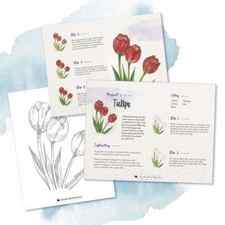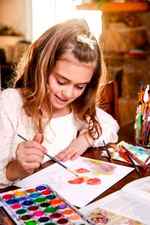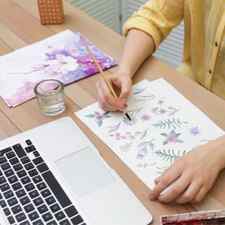Luckily for you, I’ve created the perfect monochrome watercolour course that’s beginner-friendly and engaging. Click on the image below for more details!
Easy Monochrome Painting for Beginners (A Watercolour Tutorial)
Have you ever gazed in awe at a beautiful monochromatic watercolour painting?
If so, then you’ve probably been intrigued by the painting’s unique colour palette.
A monochrome painting is a work of art that is created by using a single colour. In this way, monochromatic art uses a wide range of light and dark tones to create depth and dimension. By learning how to manipulate light and shadow, the artist can create a painting with high contrast.
What’s more, by limiting a colour palette to the tonal values of one hue, you have the ability to express atmosphere, mood, or emotion by taping into the power of colour psychology.
Cool, right? So, how do you start a monochromatic painting?
Keep reading to discover the easy step-by-step process of painting a monochrome watercolour painting with precision and ease!
Table of Contents
What is Monochrome Art?
Monochrome art is a unique art style because it can be applied to all art mediums including painting, drawing, digital illustrations, portraits, and so forth.
Monochrome art uses only one colour to convey an atmosphere, mood, emotion, or meaning. In this way, monochromatic artwork incorporates various shades and tones of a single hue to create visual interest and variation.
The benefits of creating monochrome art are many, such as:
- It helps you understand tonal values. By using a range of tonal values—ranging from very light to very dark—you learn how to create contrast
- It helps you learn about light and shadow. Developing this skill will help you create depth and dimension in your artwork
- It helps you understand the full range of your chosen colour. By creating value scales for each hue, you learn about that colour’s spectrum of tonal variety
Materials You Will Need
This easy monochromatic watercolour tutorial uses similar art supplies to regular watercolour paintings.
However, the key difference is that only one pigment is being used. I’m using cerulean blue in this demonstration, so pick a blue pigment from your palette that is similar to this hue
Now, let me share with you my list of recommended watercolour supplies for this tutorial:
- Watercolour paints (I’m using White Nights Watercolour Paints)
- Watercolour brushes (I’m using Silver Black Velvet Brushes)
- Watercolour paper (I’m using Arches Cold-Pressed Paper)
- Mixing palette (I’m using Meeden Porcelain Mixing Palette)
- Masking tape (I’m using Pro Artist Tape)
- Heat tool/gun (I’m using Mlife Mini Heat Gun)
- White ink (I’m using Winsor & Newton White Ink)
- 2 jars of water
Related: Check out this article if you’re interested in a detailed list of watercolour supplies and recommendations.
Easy Watercolor Ideas
Click below to download the free step-by-step instructions for how to turn an outline of tulips into this detailed watercolor. Use the rabbit and butterfly sketches to practice the techniques found in this blog.


Jump ahead in the blog post to learn more about. . .
- Top watercolor materials and how to care for them
- Watercolor paper options
- Watercolor techniques
- Artists’ tips for painting with watercolors

Watercolor Brushes
Investing in a set of high-quality brushes is a top priority for all new watercolor artists. Good natural and synthetic brushes are available at several price points. Using well-made brushes helps painters practice new techniques with success.
Brush Shapes
Brushes are made in various shapes and sizes. Each brush is used to create different strokes, fills, and techniques.
It is better for a beginner to have two to four quality brushes than an abundance of shapes and sizes. Choose one or two sizes of round and flat brushes to begin with if you are watching your budget.

- Round: most versatile; holds plenty of water for broad strokes and comes to a fine point for detailed work
- Flat: stiffer rectangular shape; good for washes or linear strokes
- Dagger: flat and angled; used for painting over washes or details with the sharp corner
- Wash: like a larger flat brush; used to wet the paper or create large, sweeping strokes
- Mop: wide but comes to a fine point; good for thin and wide strokes and for blending
- Detail: There are many other specialty brushes to explore!

Brush Care
Watercolor brushes are softer and more delicate than acrylic brushes and need proper care.
- New brushes should be rinsed with warm water before their first use.
- After that, always use cold water to rinse your brushes.
- Wet your brush before dipping it in paint.
- Do not let your brushes sit in water.
- Rest your brush on a dry towel or sponge.
- Once your brushes are completely dry, store them, bristles up, in a jar.

Proper cleaning and care of your brush set will help your brushes last for many years.
Watercolor Paper
Watercolor paper varies in texture and weight. The paper you choose depends on the details of the project and techniques you decide to use.

Textures
- Hot-pressed paper: smooth, even texture
- Cold-pressed paper: medium texture
- Rough: rough texture
Weights
- 90 lb: thin
- 140 lb: most common
- 300 lb: thick, sturdy

When choosing watercolor paper, consider the erasability of the paper. Watercolor artists will often sketch outlines on their paper before painting.
Being able to completely erase marks on the paper without damaging the paper helps to create a beautiful final product.





